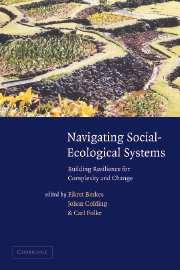Book contents
- Frontmatter
- Contents
- List of contributors
- Preface
- Acknowledgements
- Foreword: The backloop to sustainability
- 1 Introduction
- Part I Perspectives on resilience
- Part II Building resilience in local management systems
- 5 The strategy of the commons: history and property rights in central Sweden
- 6 Management practices for building adaptive capacity: a case from northern Tanzania
- 7 Living with disturbance: building resilience in social–ecological systems
- Part III Social-ecological learning and adaptation
- Part IV Cross-scale institutional response to change
- Index
- References
5 - The strategy of the commons: history and property rights in central Sweden
Published online by Cambridge University Press: 13 August 2009
- Frontmatter
- Contents
- List of contributors
- Preface
- Acknowledgements
- Foreword: The backloop to sustainability
- 1 Introduction
- Part I Perspectives on resilience
- Part II Building resilience in local management systems
- 5 The strategy of the commons: history and property rights in central Sweden
- 6 Management practices for building adaptive capacity: a case from northern Tanzania
- 7 Living with disturbance: building resilience in social–ecological systems
- Part III Social-ecological learning and adaptation
- Part IV Cross-scale institutional response to change
- Index
- References
Summary
Introduction
An understanding of the interdependencies between social and ecological systems in relation to the concept of resilience includes two basic dimensions, time and space (Holling, 1986; Holling, Gunderson, and Peterson, 1993). On a methodological level, the first has to do with the problem of what time frame should be used when analyzing the interplay between ecological and socio-economic systems. The contemporary debate about global warming is one example of this problem: should possible changes be assessed over years, centuries, or perhaps millennia? Because humans are social creatures, we have rather good historical records about the development of society. However, when it comes to the history of the interplay between social and ecological systems, the information is much scarcer. Uncertainties concerning the magnitude of deforestation in Africa exemplify this problem. No one really knows how much forest there was before colonization. There is a significant lack of forest data from that period (Gibson, McKean, and Ostrom, 1996). Moreover, even if such data were available, to what specific kind of behavior or decisions could observable changes be attributed?
The other problem, the space problem, is exemplified by findings from an ongoing research project dealing with the Russian forest sector. Along many important transportation lines in West Siberia and several other Russian forest regions, a systematic over-cut has been conducted (cf. Carlsson and Olsson, 1998; Carlsson et al. 1999). However, this local over-cutting has sometimes been ‘compensated for,’ and thereby also hidden in the statistics, by undercutting in other areas.
- Type
- Chapter
- Information
- Navigating Social-Ecological SystemsBuilding Resilience for Complexity and Change, pp. 116 - 131Publisher: Cambridge University PressPrint publication year: 2002



